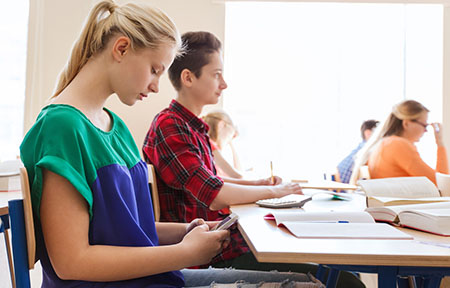
By Jake Goodrick
Gillette News Record
Via- Wyoming News Exchange
GILLETTE — The effects of social media on children and teens remain unclear despite mounting evidence showing potential dangers of those platforms on behavior and development.
To this point, social media and technology have far outpaced the research and literature studying their effects on users.
So when it comes to adapting to the ever-evolving state of social media and the technology it involves, researchers and providers say it’s important for parents and guardians to take early action.
“Having more of those boundaries earlier on than later,” said Campbell County Health psychiatrist Dr. Gilbert Smith, of social media safety. “You’re basically giving this huge device to kids and it just becomes very overwhelming.”
Social media platforms are accessible through a variety of mediums, ranging from smartphones, computers, tablets and more. To prepare children who may begin engaging with social media, it’s helpful to compare teaching them about social media safety to teaching about an unassuming parallel: gun safety.
“When you go hunting, what type of stuff do you talk to them about?” Smith said. “Safety checks, that type of thing. You have to think of the same thing with social media, or (before) you give the kid a tablet or social media. It’s similar. You have to have that same mindset.”
Before knowing the solutions, it’s important to understand the risks, so much as they can be understood.
Knowing the risks
There have been concerns about social media use throughout the duration of the technology-driven shift to online communication.
One of the bigger concerns now is how unclear the effects of social media are — good and bad — especially when it comes to mental health and adolescent development.
Not only is there sparse evidence to show whether social media is safe for kids and teens, there’s also increased evidence of potential harms social media can cause on mental health and well-being.
Earlier this year, the U.S. surgeon general spoke to that concern among others when issuing an advisory about social media effects on youth mental health, and made a call to action for policymakers and the companies running those platforms to enact changes that mitigate their harms.
“The most common question parents ask me is, ‘is social media safe for my kids.’ The answer is that we don’t have enough evidence to say it’s safe, and in fact, there is growing evidence that social media use is associated with harm to young people’s mental health,” said U.S. Surgeon General Dr. Vivek Murthy, in a press release at the time.
Up to 95% of youth ages 13-17 use social media, including more than a third of whom reported using social media “almost constantly,” according to the advisory.
Many platforms require users to be at least 13 years old, but almost 40% of children ages 8-12 reported using social media.
A child’s relationship to social media depends on a variety of factors such as time spent on the platforms, the content those platforms expose them to and the nature of the communication had on those platforms. Furthermore, those factors are weighed against the time lost toward healthier activities like exercise and sleep.
“Children are exposed to harmful content on social media, ranging from violent and sexual content, to bullying and harassment,” Murthy said in the release. “And for too many children, social media use is compromising their sleep and valuable in-person time with family and friends. We are in the middle of a national youth mental health crisis, and I am concerned that social media is an important driver of that crisis — one that we must urgently address.”
The surgeon general called for lawmakers to set age-appropriate standards for tech companies, upping protection for children’s data privacy, limiting overall access and ensuring companies share data about the health impact of their platforms, among other recommendations.
Although it remains to be seen what steps the platforms will take to assuage concerns, there are steps that parents can take to more directly intervene.
Making a plan
Just as there are a number of platforms and evolving technology for parents to keep up with, there’s similarly plenty of advice meant to help keep up with the changes.
To focus on addressing the concerns around social media, the American Academy of Pediatrics has an interactive planner that can help parents map a plan for monitoring their child’s social media use by visiting https://tinyurl.com/social-plan.
Although the organization offers a number of tips and ideas, these are some of the broader points to keep in mind:
- Keep screens out of kids’ bedrooms and have a “media curfew” for mealtimes and bedtime.
- Limit entertainment screen time to less than one to two hours each day.
- Keep computers and devices with internet access in public spaces within the home to better monitor what content is consumed and how often.
- Set firm standards on content that is and isn’t age-appropriate.
- Explain the digital footprint internet use leaves and that internet activity can be monitored and remain online for a long time.
As is often the case, communication is key — for parents to their children, but also, depending on who their children are communicating with online.
“No. 1, it’s just definitely always making sure (you know) who they’re talking to,” Smith said.
Many of the concerns branch beyond the most familiar social media platforms. A common example, Smith said, is gaming, which may entail a variety of devices and platforms connected to the internet that can link kids with strangers around the world.
“It’s more than Snapchat and Instagram but making sure of everything and investigating it,” Smith said.
Although there are plenty of concerns for parents and kids to look out for, there are positives to be found too.
“There’s some kids who may get depressed because of what they’re seeing, they may get anxious,” Smith said. “There may be some kids who are able to have life-saving events because they’re able to see an app that’s talking about anxiety … I think there’s things that can harm and things that can help, depending on how you’re looking at it.”
Whether those pros outweigh the cons remains to be seen.





